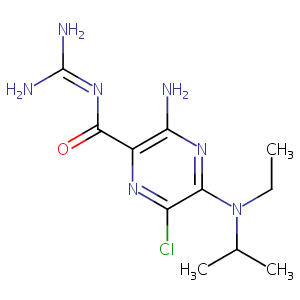Details of the Drug
General Information of Drug (ID: DM3TPMO)
| Drug Name |
5'-(N-ethyl-N-isopropyl)amiloride
|
||||||||||||||||||||||
|---|---|---|---|---|---|---|---|---|---|---|---|---|---|---|---|---|---|---|---|---|---|---|---|
| Synonyms |
EIPA; 5-(N-Ethyl-N-isopropyl)amiloride; 1154-25-2; Ethylisopropylamiloride; 5-(Ethylisopropyl)amiloride; Ethyl isopropyl amiloride; 5-(N-ethyl-N-isopropyl)-Amiloride; 3-Amino-N-(aminoiminomethyl)-6-chloro-5-[ethyl(1-methylethyl)amino]-2-pyrazinecarboxamide; N-Amidino-3-amino-5-ethylisopropylamino-6-chloropyrazine carboxamide; C11H18ClN7O; CHEMBL517986; 5-(N-Ethyl-N-isopropyl) Amiloride; 3-Amino-N-(aminoiminomethyl)-6-chloro-5-(ethyl(1-methylethyl)amino)pyrazinecarboxamide
|
||||||||||||||||||||||
| Indication |
|
||||||||||||||||||||||
| Drug Type |
Small molecular drug
|
||||||||||||||||||||||
| Structure |
 |
||||||||||||||||||||||
| 3D MOL | 2D MOL | ||||||||||||||||||||||
| #Ro5 Violations (Lipinski): 0 | Molecular Weight (mw) | 299.76 | |||||||||||||||||||||
| Logarithm of the Partition Coefficient (xlogp) | 1.3 | ||||||||||||||||||||||
| Rotatable Bond Count (rotbonds) | 4 | ||||||||||||||||||||||
| Hydrogen Bond Donor Count (hbonddonor) | 3 | ||||||||||||||||||||||
| Hydrogen Bond Acceptor Count (hbondacc) | 5 | ||||||||||||||||||||||
| Chemical Identifiers |
|
||||||||||||||||||||||
| Cross-matching ID | |||||||||||||||||||||||
Molecular Interaction Atlas of This Drug
 Drug Therapeutic Target (DTT) |
|
|||||||||||||||||||||||||||||||||||||||||||||||||||||||||||||||||||||||
|---|---|---|---|---|---|---|---|---|---|---|---|---|---|---|---|---|---|---|---|---|---|---|---|---|---|---|---|---|---|---|---|---|---|---|---|---|---|---|---|---|---|---|---|---|---|---|---|---|---|---|---|---|---|---|---|---|---|---|---|---|---|---|---|---|---|---|---|---|---|---|---|---|
 Drug Off-Target (DOT) |
|
|||||||||||||||||||||||||||||||||||||||||||||||||||||||||||||||||||||||
| Molecular Interaction Atlas (MIA) | ||||||||||||||||||||||||||||||||||||||||||||||||||||||||||||||||||||||||
References
